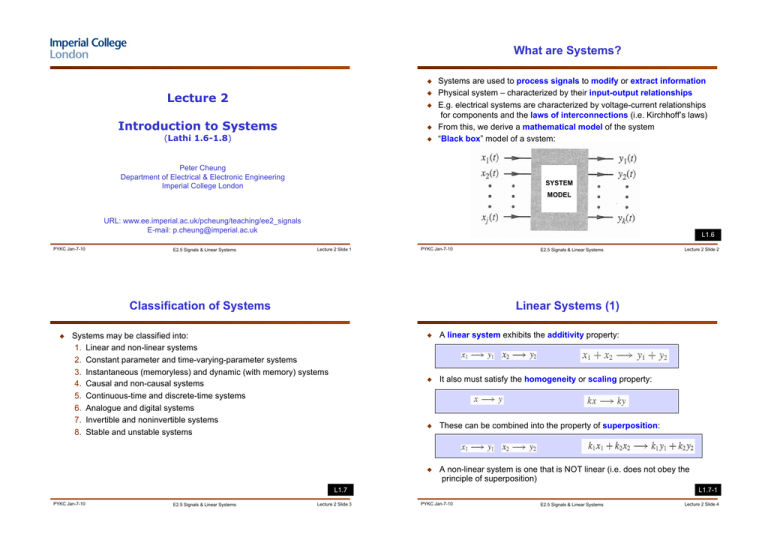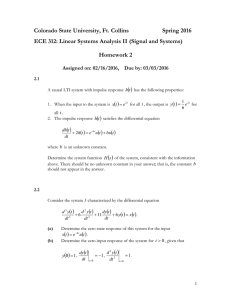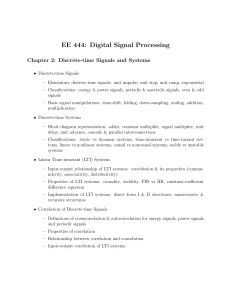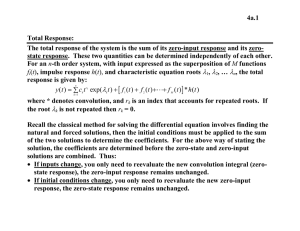Lecture 2 - Department of Electrical and Electronic Engineering
advertisement

What are Systems? ! Lecture 2 ! ! Introduction to Systems ! (Lathi 1.6-1.8) ! Systems are used to process signals to modify or extract information Physical system – characterized by their input-output relationships E.g. electrical systems are characterized by voltage-current relationships for components and the laws of interconnections (i.e. Kirchhoff’s laws) From this, we derive a mathematical model of the system “Black box” model of a system: Peter Cheung Department of Electrical & Electronic Engineering Imperial College London SYSTEM MODEL URL: www.ee.imperial.ac.uk/pcheung/teaching/ee2_signals E-mail: p.cheung@imperial.ac.uk PYKC Jan-7-10 E2.5 Signals & Linear Systems L1.6 Lecture 2 Slide 1 PYKC Jan-7-10 Classification of Systems ! E2.5 Signals & Linear Systems Linear Systems (1) Systems may be classified into: 1. Linear and non-linear systems 2. Constant parameter and time-varying-parameter systems 3. Instantaneous (memoryless) and dynamic (with memory) systems 4. Causal and non-causal systems 5. Continuous-time and discrete-time systems 6. Analogue and digital systems 7. Invertible and noninvertible systems 8. Stable and unstable systems ! A linear system exhibits the additivity property: if ! if ! ! then It also must satisfy the homogeneity or scaling property: then These can be combined into the property of superposition: if then A non-linear system is one that is NOT linear (i.e. does not obey the principle of superposition) L1.7 PYKC Jan-7-10 E2.5 Signals & Linear Systems Lecture 2 Slide 2 Lecture 2 Slide 3 L1.7-1 PYKC Jan-7-10 E2.5 Signals & Linear Systems Lecture 2 Slide 4 Linear Systems (3) Linear Systems (2) ! Consider the following simple RC circuit: ! Output y(t) relates to x(t) by: ! 1. Initial conditions when t = 0 (zero-input response) 2. Input x(t) for t ! 0 (zero-state response) ! ! A system’s output for t ! 0 is result of 2 independent causes: Decomposition property: The second term can be expanded: Total response = zero-input response + zero-state response zero-input response ! = This is a single-input, single-output (SISO) system. In general, a system can be multiple-input, multiple-output (MIMO). zero-state response + L1.7-1 p102 L1.6 (p100) PYKC Jan-7-10 E2.5 Signals & Linear Systems Lecture 2 Slide 5 PYKC Jan-7-10 Linear Systems (4) ! Show that the system described by the equation Let x1(t) ! y1(t) and x2(t) ! y2(t), then Lecture 2 Slide 6 Linear Systems (5) ! ! E2.5 Signals & Linear Systems is linear. ! ! and ! ! Multiple 1st equation by k1, and 2nd equation by k2, and adding them yields: ! This equation is the system equation with Almost all systems become nonlinear when large enough signals are applied Nonlinear systems can be approximated by linear systems for small-signal analysis – greatly simply the problem Once superposition applies, analyse system by decomposition into zero-input and zero -state components Equally important, we can represent x(t) as a sum of simpler functions (pulse or step) and L1.7-1 p103 PYKC Jan-7-10 E2.5 Signals & Linear Systems Lecture 2 Slide 7 L1.7-1 p105 PYKC Jan-7-10 E2.5 Signals & Linear Systems Lecture 2 Slide 8 Time-Invariant Systems ! Instantaneous and Dynamic Systems Time-invariant system is one whose parameters do not change with time: ! In general, a system’s output at time t depends on the entire past input. Such a system is a dynamic (with memory) system • ! A system whose response at t is completely determined by the input signals over the past T seconds is a finite-memory system • ! TI System delay by T seconds delay by T seconds TI System Analogous to a state machine in a digital system Analogous to a finite-state machine in a digital system ! Networks containing inductors and capacitors are infinite memory dynamic systems ! If the system’s past history is irrelevant in determining the response, it is an instantaneous or memoryless systems • Analogous to a combinatorial circuit in a digital system Linear time-invariant (LTI) systems – main concern for this course and the Control course in 2nd year. (Lathi: LTIC = LTI continuous, LTID = LTI discrete) L1.7-2 p106 PYKC Jan-7-10 E2.5 Signals & Linear Systems Lecture 2 Slide 9 L1.7-2 p106 PYKC Jan-7-10 Causal and Noncasual Systems ! Lecture 2 Slide 10 Continuous-Time and Discrete-Time Systems Causal system – output at t0 depends only on x(t) for t " t0 ! ! ! I.e. present output depends only on the past and present inputs, not on future inputs Any practical REAL TIME system must be causal. ! Noncausal systems are important because: ! E2.5 Signals & Linear Systems ! Discrete-time systems process data samples – normally regular sampling of T Continuous-time input and output are x(t) and y(t) Discrete-time input and output samples are x[nT] and y[nT] when n is an integer and - " # n # + " 1. Realizable when the independent variable is something other than “time” (e.g. space) 2. Even for temporal systems, can prerecord the data (non-real time), mimic a non -causal system 3. Study upper bound on the performance of a causal system L1.7-4 p108 PYKC Jan-7-10 E2.5 Signals & Linear Systems Lecture 2 Slide 11 L1.7-5 p111 PYKC Jan-7-10 E2.5 Signals & Linear Systems Lecture 2 Slide 12 Analogue and Digital Systems ! ! Invertible and Noninvertible Systems Previously the samples are discrete in time, but are continuous in amplitude Most modern systems are DIGITAL DISCRETE-TIME systems, e.g. internal circuits of the MP3 player ! ! ! ! x(t) A-D Converter x[n] Digital System y[n] D-A Converter Let a system S produces y(t) with input x(t), if there exists another system Si, which produces x(t) from y(t), then S is invertible Essential that there is one-to-one mapping between input and output For example if S is an amplifier with gain G, it is invertible and Si is an attenuator with gain 1/G Apply Si following S gives an identity system (i.e. input x(t) is not changed) x(t) x(t) y(t) System S y(t) System Si L1.7-5 p111 PYKC Jan-7-10 E2.5 Signals & Linear Systems Lecture 2 Slide 13 L1.7-7 p112 PYKC Jan-7-10 Stable and Unstable Systems ! ! E2.5 Signals & Linear Systems Linear Differential Systems (1) Externally stable systems: Bounded input results in bounded output (system is said to be stable in the BIBO sense) Stability of a system – mostly covered on the Control course ! ! Many systems in electrical and mechanical engineering where input x(t) and output loop current y(t) are related by differential equations For example: L1.7-8 p112 PYKC Jan-7-10 E2.5 Signals & Linear Systems Lecture 2 Slide 14 Lecture 2 Slide 15 L1.8 PYKC Jan-7-10 E2.5 Signals & Linear Systems Lecture 2 Slide 16 Linear Differential Systems (3) Linear Differential Systems (2) ! ! ! ! In general, relationship between x(t) and y(t) in a linear time-invariant (LTI) differential system is given by (where all coefficients ai and bi are constants): Use compact notation D for operator d/dt, i.e etc. We get: ! Let us consider this example again: ! The system equation is: ! This can be re-written as: Also and or ! For this system, N = 2, M = 1, a1 = 3, a2 = 2, b1 = 1, b2 = 0. ! For practical systems, M # N. It can be shown that if M > N, a LTI differential system acts as an (M – N)th-order differentiator. A differentiator is an unstable system because bounded input (e.g. a step input) results in an unbounded output (a Dirac impulse $(t)). ! L2.1 p151 PYKC Jan-7-10 Lecture 2 Slide 17 E2.5 Signals & Linear Systems Relating this lecture to other courses ! ! ! ! ! Principle of superposition and circuit analysis using differential equations – done in 1st year circuit courses. Key conceptual differences: previously bottom-up (from components), more top-down and “black-box” approach. Mostly consider mathematical modelling as the key – generalisation applicable not only to circuits, but to other type of systems (financial, mechanical ….) Overlap with 2nd year control course, but emphasis is different. Equation from last two slides looks similar to transfer function description of system using Laplace Transform, but they are actually different. Here we remain in time domain, and transfer function analysis is in a new domain (s-domain). This will be done later in this course and in the Control course. Time-domain PYKC Jan-7-10 s-domain E2.5 Signals & Linear Systems Lecture 2 Slide 19 L2.1 p151 PYKC Jan-7-10 E2.5 Signals & Linear Systems Lecture 2 Slide 18





